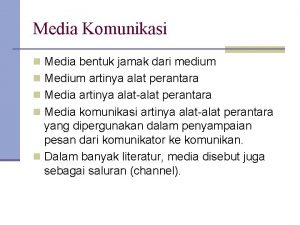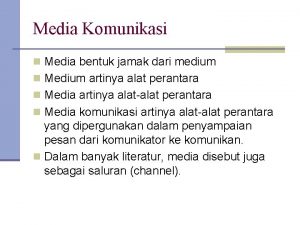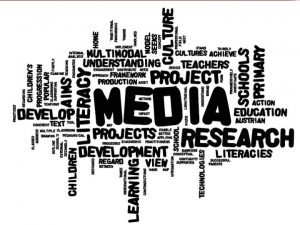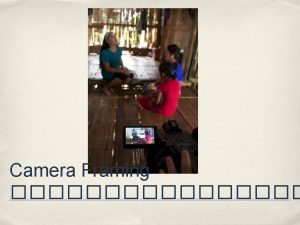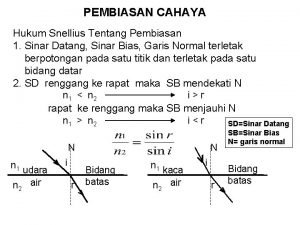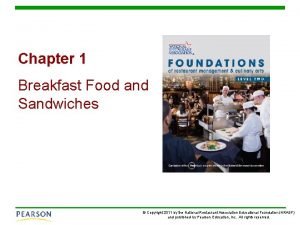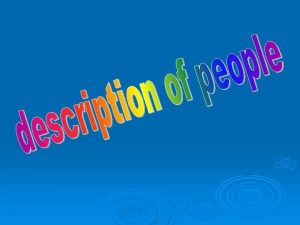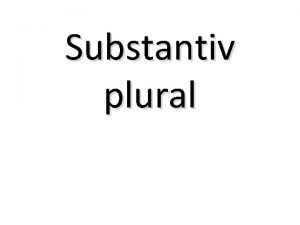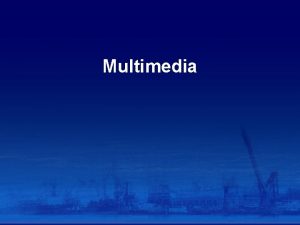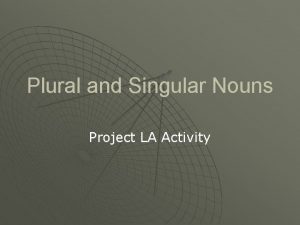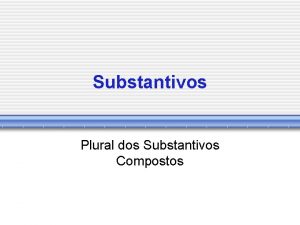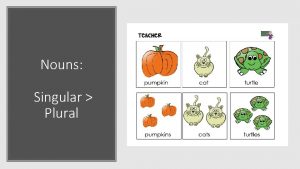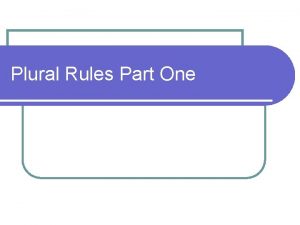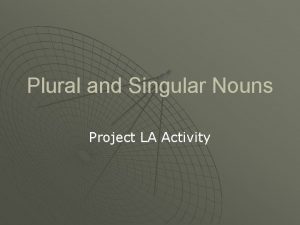What is Media Media plural of medium is



















- Slides: 19

What is Media? Media (plural of medium) is all the ways in which information can be stored and delivered, including paper, film and digital formats. l Mass Media – use of any medium to communicate information or ideas to the public. It includes newspapers, magazines, television radio, computer games and the Internet. l

Pro and anti social behaviour. l l l Pro –social - any behaviour that benefits someone else, but does not lead to an obvious reward, e. g. helping someone in need, comforting those in distress etc. Anti social behaviour – any action that is designed to arm another person or people, eg aggressive behaviour. It has been suggested that the power of mass media can alter the behaviour of children and young people.

What kind of programmes show pro and anti social behaviour All programmes show anti social and pro social behaviours including news, cartoons and the more likely source of soaps. l 2005 – average time spent watching TV men 160 minutes women 145 minutes l Heymann (1989) TV showed 5 violent acts per hour and cartoons 20. l

Media and anti social behaviour. l Many people are concerned that children may become more aggressive as a consequence of witnessing aggression. Film and television are getting more violent. Wilson et al (2002) counted 14 acts an hour in children’s television as opposed to less than 4 in adult TV. Children are increasing exposed to violent programmes designed for an adult audience. (The Professionals) More films which feature graphic and extended torture (Saw and Hostel) are increasingly popular

Influence on Physiological responses Increased arousal is part of your stress response l Zillman’s excitation transfer theory argues that arousal fro real life situations which involve conflict. l Desensitisationl

Desensitisation l l Repeated exposure to violence in the media reduces the impact of the violence. People become ‘desensitised’ to the violence and it has less impact on them (habituation). They become less anxious about violence per se and may, therefore, engage in more violent behaviour.

Cognitive Priming l l Aggressive ideas shown in media (film) can “spark off” other aggressive thoughts, (Berkowitz, 1984). After viewing a violent film, the viewer is ‘primed’ to respond aggressively. Huesmann (1982) argued that children lean problem-solving through observation and that aggressive scripts may be learnt through violent scenes. If children find themselves in the same situation in real life they may recall the violent script as a solution.

Research Studies Huesmann et al. (2003) l Gundter et al. (2002) l

Effects of watching Pro Social behaviour l Smith et al (2006) analysed the content of 18 American television channels for one week. 73% of programmes featured some pro social behaviour e. g. Sesame Street featured storylines that were designed to foster pro social behaviour linked to current events such as floods and earthquakes. In the Night Garden , Peppa Pig – sharing, family values and working together.

Research has shown that : l Regular watching of programmes with pro social content does influence how helpful children are. l

Reaserch l Fogel et al. (2007)

Explaining influences on behaviour l l l l Social Learning Theory Proposed by Bandura (1977) Children learn social behaviours by imitating other individuals. But, children do not imitate everything they see. According to SLT children imitate behaviour when four conditions are met: Observe the behaviour (model) Have to be able to remember the behaviour. Opportunity to reproduce it. Motivation to reproduce the behaviour. The motivation can be supplied when the model being observed is being rewarded in some way. The observed reward is known as vicarious reinforcement.

l http: //www. psychexchange. co. uk/videos/vi ew/20027/

Social Cognitive observational learning theory According to this theory children have an inborn tendency to imitate the behaviours which they see around them, learning via observation rather than experience. l Young children will copy both pro and anti social behaviours. l But…. l

Children who are exposed to violent models are said to develop three types of social cognitive structure: l Schemas l Scripts l Normative beliefs l

Over to you Explain why social cognitive learning theory is so strong an explanation? l What research supports this? l Explain what is meant by the third variable theory ? l

Evaluation of explanations of antisocial behaviour l l Research difficulties: this area of research has been unduly influenced by political desires to blame TV for all kinds of social problems (Gauntlett, 95). It is easier to blame ‘video nasties’ than attribute blame to other factors, such as education or poverty. In 1960, Joseph Klapper wrote that media research is too simplistic, involving counting up (quantitative/normative) the acts of aggression to assess what type of programme is under consideration. This criticism is still valid today and sophisticated methodologies remain difficult to design and elusive in practice.

Evaluation of explanations of antisocial behaviour l Much of the research into anti-social behaviour assumes that audience members all consume media in the same way and are equally influenced by it. This assumptions is not supported by the facts (Dorr & Kovaric, 81). It is also assumed that the amount of TV watched influences the amount of behaviour change. Again, this is not supported by the facts. l l It has been found that 50% of the time when children have the TV on, they are doing something else & paying little attention to the content on the screen. Finally, Cumberbatch (1989) questions why people think viewers (particularly children) will copy or imitate violent acts on the screen. They may acquire the knowledge of violent acts, but this isn’t likely to increase their desire to replicate them. Most programmes show that violence/aggression does not gain any rewards. (Negative reinforcement/Punishment)

Synopticity…. “It bleeds, it leads…” l l Cumberbatch (89) argues that media effects are filtered & selected before the public gets a chance to read them. He argues that many academic journals are more interested in publishing ‘significant’ research findings that demonstrate that violent media cause violent effects in people. Thus there is a research bias in favour of ‘positive’ findings. It is questionable how many pieces of research that have found no link between media violence and real-life violence have been excluded from publication. Furthermore, if academics know that ‘no effect’ research doesn’t get published, academics will inevitably not choose to research such areas.
 Examples of hot and cold media
Examples of hot and cold media Medium medium 35m newton
Medium medium 35m newton Media in plural form
Media in plural form Plural of medium
Plural of medium Indefinite articles in spanish
Indefinite articles in spanish Plural plural
Plural plural Media v medium
Media v medium Tcbs medium
Tcbs medium Medium berasal dari kata?
Medium berasal dari kata? Money has three functions
Money has three functions Extreme wide shot (ews)
Extreme wide shot (ews) Hukum 1 snellius
Hukum 1 snellius The dissolving medium
The dissolving medium Welded wire fence on hill
Welded wire fence on hill Shrek extreme close up
Shrek extreme close up Dvwa csrf high
Dvwa csrf high Medium weight pour batter
Medium weight pour batter Risk classification
Risk classification She has white skin
She has white skin Full shot example
Full shot example


